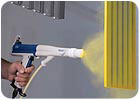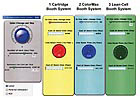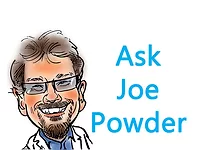A Lean, Mean Powder Coating Machine
While inventories continue to shrink and lean operations rapidly replace yesterday’s traditional production methods, choosing powder coating can be a giant step toward greater efficiency, productivity and cost effectiveness in your operations. Yet to maximize your capital equipment investment, you should first wisely invest both time and thought into your current - and future - requirements before making the move.

The advantages of powder coating are numerous, which explains in part why it remains one of the fastest growing industrial finishing methods in North America. Powder coating finishes resist scratches, corrosion, abrasion, chemicals and detergents. The powder coating process also maximizes production, cuts costs and offers maximum compliance with environmental regulations. While inventories continue to shrink and lean operations rapidly replace yesterday’s traditional production methods, choosing powder coating can be a giant step toward greater efficiency, productivity and cost effectiveness in your operations. Yet to maximize your capital equipment investment, you should first wisely invest both time and thought into your current - and future - requirements before making the move.
Today’s technology for changing colors has come a long way from changing cartridge modules on a cartridge booth or rolling complete booths on and off line. You no longer need additional powder booths and color modules for each color sprayed. Modern systems save floor space, energy and capital investment, and provide the flexibility to spray any color without purchasing new equipment. Further, current technology also provides for color changes in as little as 5 to 10 minutes with powder reclaim systems, and 20 seconds in non-reclaim systems.
New non-reclaim technology allows for changing color “on the fly” with nearly instantaneous agility. There are also new spray guns employing “dense-phase” powder delivery that can achieve more than 70% first-pass transfer efficiency. Like liquid paint kitchens, a number of powder delivery hoppers feeding a single manifold make nearly instantaneous color change a reality. This capability also narrows the cost gap considerably between reclaim and non-reclaim systems.
The booth in modern non-reclaim systems is designed to minimize airborne powder contamination so that the same low scrap and rework rates can be maintained as with reclaim equipment. Yet the greatest advance is that dense phase powder guns are designed to provide a higher first-pass transfer efficiency than ever. Not only does this design provide excellent powder coverage for difficult parts, but it also dramatically cuts down on the amount of powder used - and wasted.
These new options can enable you to find the best fit for your needs.
High-volume color-change systems. These have been the traditional workhorses of high-volume production plants that run a few large-run colors and, where it is possible, batch parts into longer production runs of a single color. The equipment includes larger cartridge reclaim systems. These installations are great for reclaiming a high percentage of powder coatings yielding high overall system efficiency of 98.5%. Frequently, these larger booths require 30 to 45 minutes for a typical color change. This group also includes multiple-booth, roll-on, roll-off designs.
Faster color-change systems. Over the past five years, a number of fast color-change systems have become popular. Color-change times have been reduced to the 10-to-15-minute range using cyclone technology, automated feed centers, and new composite booth materials that are easier to clean. Self-cleaning booths have been developed where walls and floors are automatically blown free of over-sprayed powder. These cyclone systems are popular with plants where several color changes per shift are required. Reclaiming a high percentage of powder coatings yields high overall system efficiency of 95%.
Lean systems. The most recent developments in powder are systems where it may not be possible or economically justifiable to reclaim powder coatings. If the labor cost is high, the powder cost low, and there are frequent changes, then spraying to waste may be the most sensible decision. Developments such as dense-phase powder delivery have provided enough boost in first-pass transfer efficiency that the cost gap between reclaim and spray-to-waste has narrowed considerably.
Color-on-demand systems. An added weapon in the color-change arsenal is the recent capability to automatically change colors in 20 seconds or less in a lean cell. This super-fast color-change capability allows guns and hoses to be rapidly purged for a second color.

Figure 1 is a snapshot of an interactive cost model that compares the cost of reclaiming powder versus using a spray-to-waste lean alternative. Using this model, we can experiment with virtually any number of “what if” scenarios by changing such parameters as:
The model provides for three options:
The possibilities with powder coatings are tremendous as the technology continues to evolve.

Photo courtesy of Nordson Corp.
The advantages of powder coating are numerous, which explains in part why it remains one of the fastest growing industrial finishing methods in North America. Powder coating finishes resist scratches, corrosion, abrasion, chemicals and detergents. The powder coating process also maximizes production, cuts costs and offers maximum compliance with environmental regulations. While inventories continue to shrink and lean operations rapidly replace yesterday’s traditional production methods, choosing powder coating can be a giant step toward greater efficiency, productivity and cost effectiveness in your operations. Yet to maximize your capital equipment investment, you should first wisely invest both time and thought into your current - and future - requirements before making the move.
Technology Advances
A number of technological advances have been made in powder coating over the past decade, including new and innovative ways to apply the powder and improve powder application efficiency. For some time, powder coating options have ranged from small, manual batch systems to fully automated, multi-booth, roll-on and roll-off, fast-color-change systems.Today’s technology for changing colors has come a long way from changing cartridge modules on a cartridge booth or rolling complete booths on and off line. You no longer need additional powder booths and color modules for each color sprayed. Modern systems save floor space, energy and capital investment, and provide the flexibility to spray any color without purchasing new equipment. Further, current technology also provides for color changes in as little as 5 to 10 minutes with powder reclaim systems, and 20 seconds in non-reclaim systems.
New non-reclaim technology allows for changing color “on the fly” with nearly instantaneous agility. There are also new spray guns employing “dense-phase” powder delivery that can achieve more than 70% first-pass transfer efficiency. Like liquid paint kitchens, a number of powder delivery hoppers feeding a single manifold make nearly instantaneous color change a reality. This capability also narrows the cost gap considerably between reclaim and non-reclaim systems.
The booth in modern non-reclaim systems is designed to minimize airborne powder contamination so that the same low scrap and rework rates can be maintained as with reclaim equipment. Yet the greatest advance is that dense phase powder guns are designed to provide a higher first-pass transfer efficiency than ever. Not only does this design provide excellent powder coverage for difficult parts, but it also dramatically cuts down on the amount of powder used - and wasted.
These new options can enable you to find the best fit for your needs.
Powder Equipment Options
Aside from your facility’s capital equipment budget, some key facts about your operation should weigh in your equipment decision:- How many color changes (per hour, shift, day) must be done?
- How fast can color changes be made?
- How much labor is available for color changing?
- What is the labor cost?
- How close to capacity is the line?
- How much lost production (profit on goods) is lost during downtime?
- How expensive is my powder?
- How much ability to batch parts do I have?
- What is the burdened line cost per hour?
High-volume color-change systems. These have been the traditional workhorses of high-volume production plants that run a few large-run colors and, where it is possible, batch parts into longer production runs of a single color. The equipment includes larger cartridge reclaim systems. These installations are great for reclaiming a high percentage of powder coatings yielding high overall system efficiency of 98.5%. Frequently, these larger booths require 30 to 45 minutes for a typical color change. This group also includes multiple-booth, roll-on, roll-off designs.
Faster color-change systems. Over the past five years, a number of fast color-change systems have become popular. Color-change times have been reduced to the 10-to-15-minute range using cyclone technology, automated feed centers, and new composite booth materials that are easier to clean. Self-cleaning booths have been developed where walls and floors are automatically blown free of over-sprayed powder. These cyclone systems are popular with plants where several color changes per shift are required. Reclaiming a high percentage of powder coatings yields high overall system efficiency of 95%.
Lean systems. The most recent developments in powder are systems where it may not be possible or economically justifiable to reclaim powder coatings. If the labor cost is high, the powder cost low, and there are frequent changes, then spraying to waste may be the most sensible decision. Developments such as dense-phase powder delivery have provided enough boost in first-pass transfer efficiency that the cost gap between reclaim and spray-to-waste has narrowed considerably.
Color-on-demand systems. An added weapon in the color-change arsenal is the recent capability to automatically change colors in 20 seconds or less in a lean cell. This super-fast color-change capability allows guns and hoses to be rapidly purged for a second color.

Figure 1. An interactive cost model compares the cost of reclaiming powder versus a spray-to-waste lean alternative. Courtesy of Nordson Corp.
An Interactive Computer Cost Model
Today, a number of tools are available to help you compare each option against any set of requirements. Cost models have been developed by equipment suppliers that permit detailed “what if” scenarios and allow for various input data so that you can enter what you know in the most convenient format to help you make educated decisions.Figure 1 is a snapshot of an interactive cost model that compares the cost of reclaiming powder versus using a spray-to-waste lean alternative. Using this model, we can experiment with virtually any number of “what if” scenarios by changing such parameters as:
- Color changes per hour/shift/day
- Work days per year
- Line burdened cost
- Number of guns
- Pounds of powder used per hour
- Transfer efficiency
- Powder cost per pound
The model provides for three options:
- A cartridge booth with a 35-minute color change
- An advanced color booth with a 10-minute color change
- A lean booth with a 20-second color change
A Tremendous Opportunity
Today, quick-color-change technology for reclaiming powder is rapidly replacing the powder color-change options of the past. Current users of these systems are now reclaiming hundreds of colors with a single piece of equipment. Under the right conditions, the payback for this technology investment is rapid. Determining whether your facility can benefit from this technology is also easier than ever, thanks to new computer modeling tools that allow you to compare the available options against any set of requirements.The possibilities with powder coatings are tremendous as the technology continues to evolve.
SIDEBAR: Is Quick Color Change Right for You?
The following questions can help you determine if quick-color-change technology is right for you:- Do you need to change color frequently while still reclaiming powder?
- Is color-change time important to you?
- Does your list of colors used change often?
- Is floor space a precious commodity?
- Are you looking to save energy?
- Do you have a significant number of color changes (per hour, shift, day)?
- Do you need to increase the speed of your color changes?
- Do you need to reduce the labor involved in your color changes?
- Is your line running close to capacity?
- Are you losing too much production (profit on goods) during downtime?
- Are you spending too much money on powder?
- Do you require the ability to batch parts?
- Is your burdened line cost per hour too high?
Looking for a reprint of this article?
From high-res PDFs to custom plaques, order your copy today!





